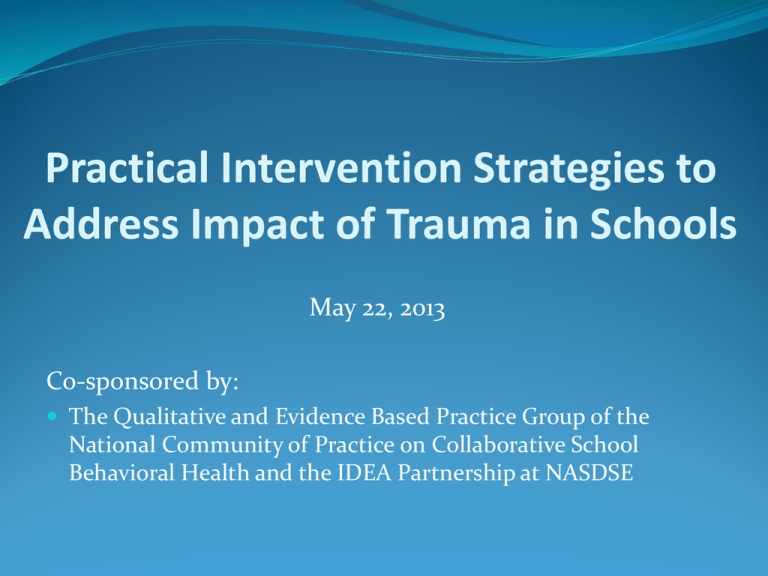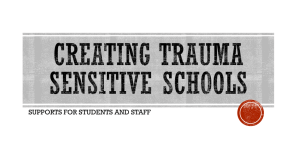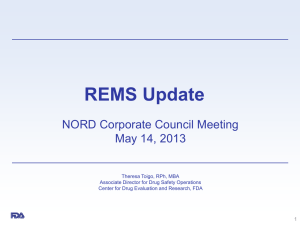Document
advertisement

Practical Intervention Strategies to Address Impact of Trauma in Schools May 22, 2013 Co-sponsored by: The Qualitative and Evidence Based Practice Group of the National Community of Practice on Collaborative School Behavioral Health and the IDEA Partnership at NASDSE The National Community of Practice (CoP) on Collaborative School Behavioral Health Co-led by the IDEA Partnership at NASDSE and the Center for School Mental Health at the University of Maryland The focus of the CoP is to collaboratively work to create a shared agenda across education, mental health and families. The National Community of Practice (CoP) on Collaborative School Behavioral Health The CoP affiliates with cross-stakeholder teams that have created 16 state CoPs modeled on the national exemplar. The CoP affiliates with 22 national organizations and 9 technical assistance centers and coalesces them around the issues they share. Together the states, organizations and TA centers lead 12 issue-based Practice Groups that develop the content and design the interaction for of the Annual Conference on Advancing School Mental Health 18th Annual Conference – October 3-5, 2013 in Crystal City- Arlington, Virgina QEBP Practice Group Mission and Priorities Co-facilitators: Nicole Evangelista Brandt, PhD, Center for School Mental Health Mark Sander, PsyD, LP, Hennepin County/Minneapolis Public Schools Sharon Stephan, PhD, Center for School Mental Health Mission: To provide resources and promote sharing of information across individuals/groups interested in improving the quality of school mental health (SMH) To discuss, promote, and disseminate evidence based practices in SMH Priority areas include: Improving dissemination and sharing of evidence-based practices in SMH Bridging the research-practice and practice-research gaps in the field Understanding and promoting the use of the best student-, program-, and school-level evaluation strategies. http://www.sharedwork.org/ Follow up … Archived recording of webinar and PowerPoint slides http://www.sharedwork.org/web/school-behavioralhealth/home Center for School Mental Health http://csmh.umaryland.edu/Resources/ArchivedWebinars/in dex.html PSYCHOLOGICAL FIRST AID: Listen Protect Connect/Model and Teach Copyright M. Schreiber, R.H. Gurwitch, & M. Wong, 2006 Adapted, M. Wong, 2012 6 Presented by Marleen Wong, Ph.D., Associate Dean and Clinical Professor University of Southern California, School of Social Work REMS TA Center http://rems.ed.gov 7 • Technical Assistance • Website Resources • Online Training Courses • On-Site Trainings by Request Prevention -Mitigation Recovery Preparedness Response U.S. Department of Education (ED) Office of Safe and Healthy Students (OSHS) 8 What is Psychological First Aid? • Psychological First Aid is a set of supportive actions that help people cope more effectively during times of stress. • American Red Cross 9 With Psychological First Aid Every adult who interacts with a child plays an important role 10 Why is PFA Important? 11 • Knowing how to provide Psychological First Aid can help you to: • Create a compassionate environment for everyone in the school. • Assess what someone may need at the moment. • Provide immediate support to those in stressful situations. • Help others cope in the face of stressful events. Guidelines for PFA • Keep boundaries • Be tolerant of differences • Respect people’s privacy • Take care of yourself • Know when to ask for help 12 The Goals of PFA • Establish safety • Stabilize the emotions and behaviors • Return your colleague to an improved mental and emotional state to the family - ready to resume education and re-engage in their family 13 Adjustment Over Time in Crisis A = baseline functioning B = event C = vulnerable state D = usual coping mechanisms fail E = helplessness, hopelessness F = improved functioning G = continued impairment (PTS) H = return to baseline I = post-traumatic growth I A B H C G F D E How Does an Adult Begin to Recover? It begins with the the acknowledgement that there is a problem 15 For Survivors Directly Affected • • • 16 Parents and students turn to schools for help after a community tragedy. Schools are often shelters after a disaster and become the primary source of community support. K-12 schools are one of the first “service agencies” to resume operations after community crisis or disaster. Psychological First Aid after Traumatic Crises: The Responsibility of Caring Adults • Listen • Protect • Connect • Model • Teach 17 Listen • Encourage to share experiences and express feelings of fear or concern. • Be willing to listen and respond to verbal and nonverbal cues. • Give extra reassurance, support, and encouragement. 18 Listen: You want to convey your interest and empathy • Where were you when this crisis happened? • What was your first thought? • What do you remember about that day? 19 Protect • Maintain structure, stability, and predictability. Have predictable routines, clear expectations, consistent rules, and immediate feedback. • Keep your ears open and eyes watchful, especially for aggression toward students, parents, teachers, or administrators. • Keep environment free of anything that could re-traumatize. • Validate the person’s life experience. 20 Protect (cont.) • What’s the most difficult thing for you to deal with right now? • Are you worried about how you are reacting? • Are you worried about your safety?... • Around students? • Around adults at school or outside of school? 21 Connect • Check in with colleagues on a regular basis. • Encourage interaction, activities, team projects, trusted family members, teachers. • Refer or talk to counselors. • Keep track of and comment on what's going on in their lives. • Share positive feedback from students, parents, teachers, and other adults. 22 Connect (cont.) • What would make things easier to cope with? • What can I do to help you right now? • What can your family members do? • What can your peers or administrators do to help? • What can your friends do to help? 23 Model Calm and Optimistic Behavior • Maintain level emotions and reactions – Stay in the middle – no highs or lows – to help them achieve balance. • Take constructive actions to assure school safety. • Express positive thoughts for the future. • Help colleagues to cope with day to day problems. 24 Teach About Normal Stress Symptoms and How to Cope Acknowledge the normal changes that can occur in people who are traumatized or grieve: • Physical Changes • Emotional Changes • Cognitive Changes • Changes in Spiritual Beliefs 25 Help to problem solve: • How to come to work/school everyday. • How to stay at school everyday. • How to get along and enjoy friends and family. • How to manage planning and professional development. Adults’ Issues That Affect Students • Adults may not recognize distress in students or others. • Adults may be preoccupied with their own issues. • Adults may not validate student’s reactions to trauma. • Communication between adults may be poor. • Adults may be compliant in the aftermath of an event, while silently suffering. 26 PFA/LPC in Practice • LISTEN, PROTECT, CONNECT • Empathetic, active listening • Taking steps to protect • Connect with them • MODEL, TEACH • Map their own supports • Build a basic self-care plan with follow through 27 Evaluating Efforts Desirable Outcomes • Returns to average educator and student attendance • Resumes peer and student relationships • Maintains academic achievement of class(es) • Look at grades and standardized tests scores Undesirable Outcomes • Increased discipline referrals • Educators absenteeism • Resignation 28 Extra Understanding and Patience BUT… • Educators, administrators, and school staff should maintain their expectations for behavior and performance and should maintain discipline. • At the same time, however, they can be prepared to provide extra support, encouragement, and crisis counseling, if needed, to help other educators return to the school, and help students succeed in school. 29 Additional Resources • Listen, Protect, Connect, Model, and Teach: Psychological First Aid for Students and Teachers http://www.ready.gov/sites/default/files/documents/files/PFA _SchoolCrisis.pdf • REMS Helpful Hints, “Psychological First Aid (PFA) for Students and Teachers: Listen, Protect, Connect - Model & Teach” http://rems.ed.gov/docs/HH_Vol3Issue3.pdf Additional resources, worksheets and exercises will be posted with the archived webinar on the REMS TA Center website http://rems.ed.gov 30 Contacting the REMS TA Center TA requests can be made via telephone Monday through Friday. E-mail requests are responded to during business hours of operation. Whatever you need, we're willing to help! Requests for assistance can be made: • Telephone: 1-866-540-7367 (REMS) • When you have a quick question, follow-up (e.g., training events). • Website: http://rems.ed.gov/ • When you need information or resources, or would like to request TA through the online request form. • E-mail: tasupport@remstacenter.org 31 • When you have a question or need assistance. Building a Collaborative System for Educating Traumatized Students Eric Rossen, PhD, NCSP National Association of School Psychologists (NASP) Today’s topics • Creating trauma sensitive classrooms and schools • Integrating learning supports in schools to help students with trauma histories • Utilizing existing school-based mental health supports • Empowering all educators Learning Objectives • At the conclusion of today’s presentation, attendees should be able to: ▫ Recognize the drawbacks of relying solely on traditional models of treatment ▫ Understand the importance of developing trauma sensitive classrooms ▫ Support practices that supplement direct clinical intervention services for students with trauma histories What We Know • Virtually every classroom has one or multiple children with adverse experiences • For many students these experiences begin at an early age and are chronic • Adverse events can impact behavioral and academic performance • These data suggest the need for a new paradigm to support these students. ▫ Especially in schools with a high population of students living in poverty Poll Question • Should students with documented trauma histories that exhibit symptoms of a disability that overlap with symptoms of trauma receive special education services? • Yes • No • Depends Drawbacks of Traditional Models • Higher likelihood of: ▫ ▫ ▫ ▫ ▫ False positives (identification) Misidentification and application of interventions Potential for a binary system Perpetuating mistrust Ineffective use of resources NY Times Op-Ed (July, 2012), referring to a high poverty public school in NYC • “The traditional therapist’s response, of course, is to recommend therapy for traumatized children. But that’s an impossible solution in a big-city school of 1,000 or more students.” http://www.nytimes.com/2012/07/28/opinion/noceraaddressing-poverty-in-schools.html Limitations of Tier III Evidence Based Treatments • • • • Time/Difficult to complete entire EBT protocols Resources/Cost Efficiency Hard to build school ownership Potential for disconnect between mental health providers and other adults that spend every day with the student • Students that may need support not always identified • Clinical services not always implicated • Wait to Fail Model What do we suggest? • Supplementing (NOT supplanting) EBT with classroom-based support by building TraumaSensitive Classrooms and Schools ▫ ▫ ▫ ▫ ▫ Raising awareness Empowering Educators Providing support throughout the day to all students Consultation Increasing effective use of time and knowledge Supplementing Clinical Interventions • Teachers have a stake in responding to trauma due to its impact on behavior and learning • Giving teachers the ability to address interfering factors is essential for enabling learning • Unify mental health and learning • Provides support for all students throughout the day • May help prevent need for intensive services Poll Question • Are classroom teachers equipped to provide critical supports to traumatized students? • Yes • No Same Op-Ed from NY Times (7/27/2012) • “The most disruptive children dominated the schools. Teachers didn’t have control of their classrooms — in part because nothing in their training had taught them how to deal with traumatized children.” • “…there are few, if any, pre-service teacher preparation programs that help educators to develop skills and coping strategies to detect and teach traumatized, depressed, or anxious students.” Wong, M. (2008). Interventions to reduce psychological harm from traumatic events among children and adolescents: A commentary on the application of findings to the real world of schools. American Journal of Preventive Medicine, 35, 398–400. Empowering All Educators to Play a Role In Supporting Traumatized Students • Provides a different paradigm for why children are not achieving • Improves: • IEP development • behavior intervention development • support for therapeutic recommendations • discipline practices Ahmed: True Story *Name Changed • You receive a referral for a Muslim student, age 11 years, because he often seems frustrated and angry, and sometimes gets into fights with other students. The teacher reports that while he is often teased, he loses his temper easily and can get aggressive. • How would you typically respond? Ahmed continued • Ahmed is originally from Somalia, where he saw his father and older brother murdered. He fled with his mother and two younger sisters, leaving behind other family members he was close with. After spending time in a refugee camp in Kenya, the family was admitted to the US with refugee status. Although successfully resettled in the Midwest, Ahmed’s mother is having difficulty making ends meet, and they live in a lowincome, high-crime neighborhood. Kids at school call him “Osama” and tease him for not knowing much English and being so thin. Examples For All Educators • Immigrant Students ▫ Incorporate information about country of origin into classroom activities ▫ Identify local immigrant community organizations ▫ Focus on student strengths ▫ Support maintenance of home culture ▫ Engage immigrant families as part of school community ▫ Recruit mentors ▫ Promote tolerance Examples For All Educators • Student Experiencing Sexual Abuse ▫ Understand cultural differences ▫ Respond to disclosure with empathy and without judgment ▫ Help locate and identify needed supports ▫ Be observant ▫ Know the law Examples For All Educators • Students with Parents Involved in Substance Abuse or Dependence ▫ ▫ ▫ ▫ ▫ ▫ Think practically Don’t keep it a secret/know the law Meet basic needs Know what to say Become a source of information Connect with caregivers (even substance abusing parent) Creating Trauma Sensitive Classrooms and Schools A Three-Legged Stool Major content areas: Learning Supports Instructional Component Learning Supports Component • Building teacher capacity to re-engage disconnected students • Providing support for the full range of experiences that students and families encounter • Responding to and preventing academic, behavioral, social–emotional problems and crises Management Component • Increasing community and family involvement and support • Facilitating student and family access to effective services and special assistance as needed Utilize School-Employed Mental Health Professionals/Learning Supports • Consultation ▫ Individual or classroom level • • • • Staff training Identifying resources Participation in team/committee meetings Improve assessment ▫ Routinely include questions about childhood events, stressors, problems at home or community, etc. • Data collection Benefits of Trauma-Sensitive Schools and Classrooms • Supportive of primary mission of schools • Provides supports to all students (prevention) • Provides tools to school staff and students to respond to distress • Supports teachers and reduces burnout • Improves the “presence” of mental health providers in schools • Improves student outcomes Benefits of Trauma-Sensitive Schools and Classrooms • Increasing students’ sense of safety and connectedness: ▫ Reduces stress response ▫ Increases availability to learn ▫ Increases adoption of prosocial norms Common themes • • • • School-wide focus Building safe environments Building student capacities Building staff capacities Takeaways From This Series • Trauma impacts the learning, behavior, and mental health of many students • Knowledge of these factors continues to evolve • Trauma has traditionally been difficult to identify and distinguish from psychological disorders or educational disabilities • The traditional “wait to fail” disorder model is insufficient to support and educate students impacted by trauma (you can’t do it alone) • Mental health providers are key players in creating trauma-sensitive systems By the way… • Don’t forget to take care of yourself! • Secondary traumatic stress is real ▫ ▫ ▫ ▫ ▫ Working with vulnerable students Empathy Insufficient recovery time Unresolved personal trauma Lack of resources • Taking care of yourself is not selfish – it helps you help others. Resources ▫ RAND: How You Can Help Students Recover from Traumatic Experiences (Free) ▫ Creating Trauma Sensitive Schools to Improve Learning: WI Dept. of Public Instruction (Free) ▫ Helping Traumatized Children Learn [Trauma and Learning Policy Initiative (Free) ▫ Child Trauma Toolkit for Educators: NCTSN (Free) ▫ Massachusetts Trauma Sensitive Schools website (www.doe.mass.edu/tss/) ▫ Supporting and Educating Traumatized Students: A Guide for School-based Professionals (DISCLAIMER) THANK YOU Eric Rossen erossen@naspweb.org www.nasponline.org










